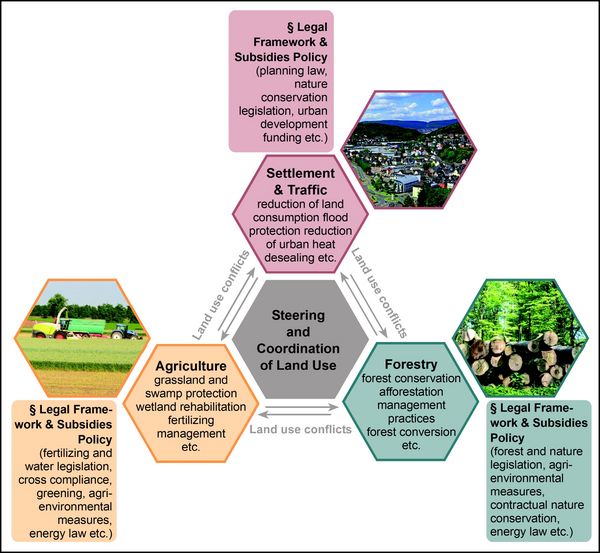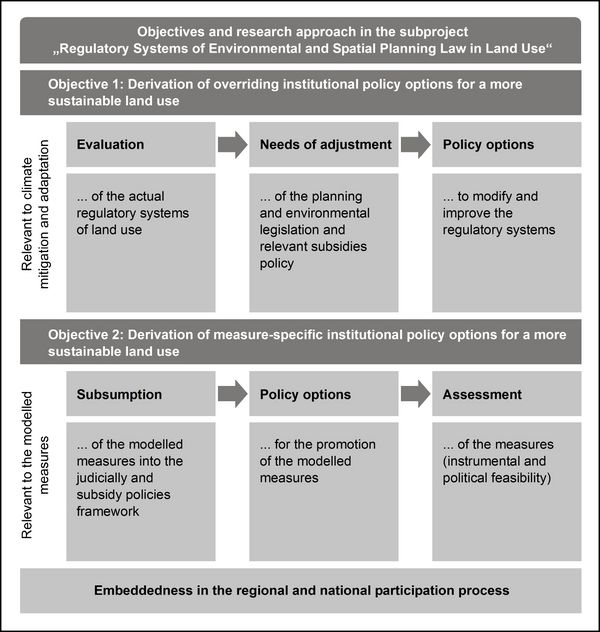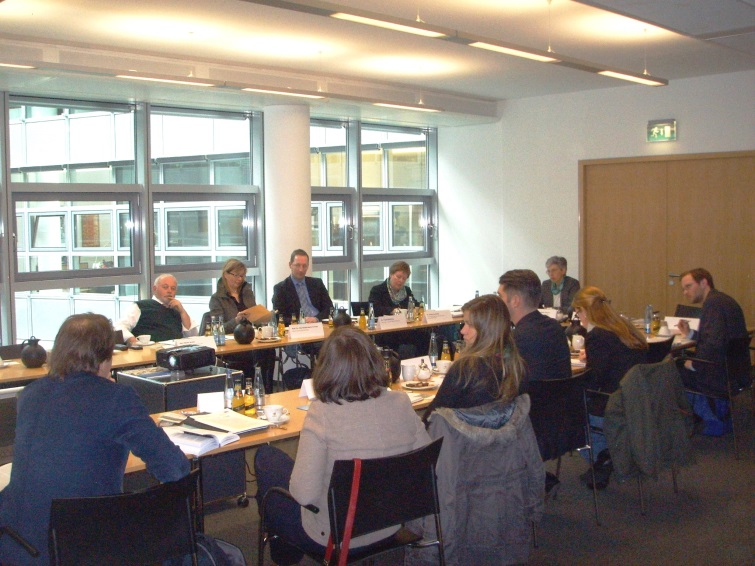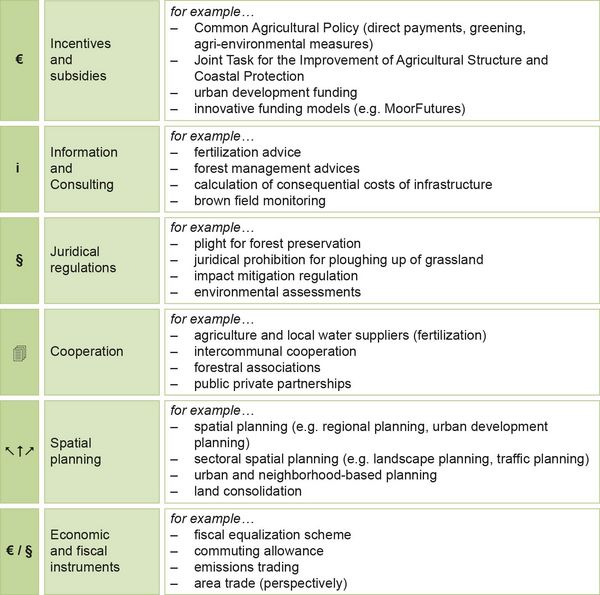Regulatory systems
Title of the subproject:
Regulatory Systems of Environmental and Spatial Planning Law in Land Use
Introduction:
The subproject focuses on the options of steering land use and influencing land use decisions. It contributes to the comprehension of the interrelations between land use decisions an planning-societal-economic framework conditions. Thereto aspects of the instrumental feasibility of sustainable land use strategies are taken in consideration in addition to scientific-technological aspects. In this way scientific findings can be presented to answer the question, how different institutional actors (politics, administration, organizations, private actors etc.) can contribute to climate mitigation and adaptation and which kind of instruments can counterbalance the different demands on land use.
Institution:
University of Münster
Department of Geography
Chair: Local, Regional and State Development / Spatial Planning
Subcontractors:
Central Institute for Spatial Planning at the University of Münsterplaninvent – planning office for spatial planning in Münster
Aims
Land use decisions are not only based on given location factors, but are also subject of the environmental and planning regulatory framework and of the incentives of subsidy policies and influencing private and public stakeholders or institutions through negotiation and developing strategies. These complex hybride and flexible governance-systems shape actual regulatory systems of land use.

The emerging climate change and the necessary adaptations in land use set new challenges for a sustainable land use management. Insofar the question arises, if the actual regulatory systems of land use can satisfy these challenges and if the existing instruments are suitable to implement the CC-LandStraD strategies and measures
Therefore the objective of the subproject was:
- a criteria-based evaluation of the existing steering instruments of land use and – based on that –
- the derivation of overriding institutional policy options as well as
- the derivation of measure-specific institutional policy options for a sustainable land use management.
To do so, the CC-LandStraD measures were assessed according their legal and instrumental feasibility and their political and societal feasibility.

Research approach and methods

To achieve the formulated objectives, different methodical approaches were applied: Initially, the relevant regulations, laws and instruments were evaluated regarding their ability of adaptation and necessary modifications. The evaluation encompassed all kinds of instruments, regulations, planning processes, strategies, incentives and different kinds of informal cooperation, which can influence land use decisions.
The assessment was based on the following criteria:
- suitability: Concerning the question if in an instrument shows direct or indirect relations to climate change and/or land use,
- implementation: Concerning the question which impulses on the promotion of mitigation and adaption in land use can be driven from the instrument / from its implementation andor from its impacting element,
- binding effect: Concerning the question how far the binding statutory effect of a regulatory and/or a management approach prepares the implementation of measures for mitigation and adaption in land use,
- practical relevance: Concerning the question, which significance a regulatory and/or management approach has for a sustainable, adaptive land use.
In addition, the assessment analyzed, which target audience is addressed by the instrument and which interrelations can be identified to the CC-LandStraD-measures.
The results of this evaluation were harmonized and supplemented by a widespread literature and documentary analysis. Furthermore the lessons learned of the stakeholder involvement were taken into consideration. Besides, the derived policy options for the modification of steering instruments were juridically verified und aligned with the relevant project partners.
Results
The results of the evaluation of the relevant instruments in land use management built the guiding principles for the derivation of institutional policy options. Hereinafter the most important findings of the subproject will be presented. A comprehensive depiction can be found in the CC-LandStraD final report of the subproject.
In conclusion, it can be emphasised that in the past years an extensive anchoring of issues of mitigation and adaptation in the European and German environmental and planning legislation as well as in different subsidy policies has taken place. To implement a (more) sustainable land use management there are already multiple types of instruments in different political sectors and on all administrative scales available.

At the same time the analysis show that different instruments need to be modified and optimized in regard to climate mitigation and adaptation (e.g. environmental assessments, fertilization law, management of compensational areas) and that in some fields of action implementation deficits need to be faced (e.g. protection of grassland, reduction of land consumption, flood protection). Furthermore, climate mitigation and adaptation need to be taken into greater account in different subsidy policies (e.g. Common Agricultural Policy, urban development funding). The high relevance of informal instruments could be confirmed. Furthermore, instruments came into focus, which were only sporadically brought into connection with climate change land use so far.
Cross-sectoral it could be shown that the interaction between different instruments and the concrete configuration of governance-systems (cooperation and coordination between actors and institutions) is of high relevance for the successful implementation of climate mitigation and adaptation measures.
Building on the results of these analysis overriding and measure-specific policy options could be derived. On the overriding level the following fields of action were of high relevance:
- A more effective steering and coordinating of land use through spatial planning;
- A strengthened consideration of the consequences of climate change in spatial planning;
- The further development of landscape planning;
- The further development of the management of compensational areas;
- The further development of the Common Agricultural Policy;
- The stronger consideration of climate change topics in informal planning approaches;
- The strengthening of strategic approaches in land management;
- The implementation of a more integrated environmental monitoring.
Regarding the modelled CC-LandStraD-measures in the three sectors the subproject developed a widespread assessment of the juridically-instrumental feasibility of these measures. For each measure a detailed analysis with information about the content and objective of the measure, its juridically-instrumental and political parameters, identified implementation obstacles and concrete policy options is now available.
In summary it can be said that the interaction of different instruments is crucial: The focus should be on the identification of conflicting objectives and synergies, for example between nature conservation and climate protection. With regard to the configuration of planning and juridical instruments as well as subsidy policies an “instrumental overload” should be prevented. Especially regulatory law should be deployed only if cooperative, informative or incentive instruments are not sufficient enough. In reference to tightly controlled public funding it can be expedient to focus on measures, which are of high relevance detached from climate change (no regret measures).

